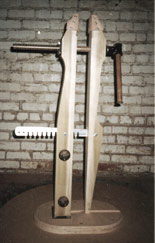 |
||||
| Baluster Vertical supports between handrail and treads or stringers, usually more delicate than newel posts. Vertical supporting member of a balustrade. Balustrade The combination of rail and posts or balusters that support it, forming a guard rail. Bull step Commonly the bottom step which projects beyond the stringer in a half round shape. | ||||
| Buttress stringer A built up, closed stringer with no supporting wall beneath it. Closed stringer An uncut stringer into which the treads are housed so that they are not visible from outside of the stair. Cove molding A rectangular trim with the prominent corner of a concave shape. Often used as scotia. Easing A curved, cut away transition at pitch changes in handrails and stringers. Fascia board A trim piece at gallery areas or at closed stringers situated beneath a landing strip or the balustrade shoe. Elevation A drawing of the side, front or rear of a structure or object. Finial An ornamental terminating part, such as a ball atop a newel post. Handrail A shaped rod or rail that conforms to the stair pitch, or runs level at the landings, and forms the top of a balustrade. Head room The height directly above the stair nosings to the ceiling or soffit above—an important code issue. Housing The grooved portions of a closed stringer, precisely routed away to accept treads, risers and wedges. Laminate To glue together boards, either edge-to-edge or face-to-face. Also, to glue a veneer to another surface. Landing strip The transition nosing piece at landings matching typical tread noses on the front and floor thickness on back edge. Mitered return A perpendicular end cap on open stringer treads, covering the end grain. Newel post A starting or landing post providing the main support of a balustrade. Also the center column of a spiral staircase. Open stringer A stringer cut to accept treads and risers, providing an even pattern. Riser cuts are usually mitered. Pitch The angle of incline provided by the repetition of stair nosings. Plan view A bird’s eye view. The layout as seen from above. Plinth A mitered wrap of boards at the base of a column or post. Projection The measurement of a tread’s overhang beyond the riser or stringer. Rise The measurement in height from one tread to another. Riser The vertical, structural assembly piece of a staircase upon which the tread sits. Scotia A molding under the stair tread projection and against the riser or stringer—frequently of cove molding. Scroll step An older name for a bull step or bull-nosed step. Soffit The underside of a part of a building, as of an overhang or staircase. Spiral staircase Usually a stair, with a tight and consistent radius, ascending around a column though sometimes with a steep inside stringer. Staircases of greater diameter are generally referred to as circular. Stringer The structural staircase member that supports the treads and risers. Tread The upper, horizontal part of a step. Turnout A simplified version of a volute. Volute A spiral or scroll shaped form. Sometimes a volute is the terminus of a handrail, and is curved both in plan view and elevation—historically this was called a wreath or scroll. Winder tread An irregularly shaped tread, wider at one side than the other. Spiral stairs use a type of winder tread. |
||||